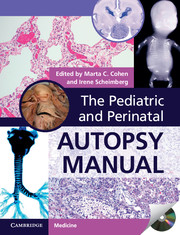Book contents
- Frontmatter
- Contents
- List of contributors
- Foreword
- Preface
- Acknowledgments
- 1 Perinatal autopsy, techniques, and classifications
- 2 Placental examination
- 3 The fetus less than 15 weeks gestation
- 4 Stillbirth and intrauterine growth restriction
- 5 Hydrops fetalis
- 6 Pathology of twinning and higher multiple pregnancy
- 7 Is this a syndrome? Patterns in genetic conditions
- 8 The metabolic disease autopsy
- 9 The abnormal heart
- 10 Central nervous system
- 11 Significant congenital abnormalities of the respiratory, digestive, and renal systems
- 12 Skeletal dysplasias
- 13 Congenital tumors
- 14 Complications of prematurity
- 15 Intrapartum and neonatal death
- 16 Sudden unexpected death in infancy
- 17 Infections and malnutrition
- 18 Role of MRI and radiology in post mortems
- 19 The forensic post mortem
- 20 Appendix tables
- Index
- References
8 - The metabolic disease autopsy
Published online by Cambridge University Press: 05 September 2014
- Frontmatter
- Contents
- List of contributors
- Foreword
- Preface
- Acknowledgments
- 1 Perinatal autopsy, techniques, and classifications
- 2 Placental examination
- 3 The fetus less than 15 weeks gestation
- 4 Stillbirth and intrauterine growth restriction
- 5 Hydrops fetalis
- 6 Pathology of twinning and higher multiple pregnancy
- 7 Is this a syndrome? Patterns in genetic conditions
- 8 The metabolic disease autopsy
- 9 The abnormal heart
- 10 Central nervous system
- 11 Significant congenital abnormalities of the respiratory, digestive, and renal systems
- 12 Skeletal dysplasias
- 13 Congenital tumors
- 14 Complications of prematurity
- 15 Intrapartum and neonatal death
- 16 Sudden unexpected death in infancy
- 17 Infections and malnutrition
- 18 Role of MRI and radiology in post mortems
- 19 The forensic post mortem
- 20 Appendix tables
- Index
- References
Summary
Introduction
When an infant or young child dies suddenly or after a brief hospitalization, without a specific diagnosis, and is suspected by the clinician to have a metabolic disease, an important question for the pathologist is which investigations to pursue as part of the autopsy. In this situation, both the clinician and the pathologist are seriously disadvantaged. Many metabolic diseases evolve slowly, meaning time is needed for recognition followed by thoughtful disease-focused ante-mortem diagnostic testing. When this luxury has been preempted by circumstances, the quest for understanding the biological basis for a seemingly inexplicable death is not hopeless. In fact, the possibility for success using modern tools has never been greater.
To determine how to proceed, a pre-autopsy discussion between the pathologist and the clinician is essential. Issues of cost and reimbursement eventually emerge, but this can be managed by making choices focused and dictated by the situation at hand in order to have the greatest chance of success. The essential components of a systematic assessment reside in the details of clinical presentation, the family history, the available ante-mortem laboratory data, and the gross and microscopic findings. This information will influence the details of specimen collection and guide subsequent decisions about testing.
- Type
- Chapter
- Information
- The Pediatric and Perinatal Autopsy Manual , pp. 120 - 138Publisher: Cambridge University PressPrint publication year: 2000



